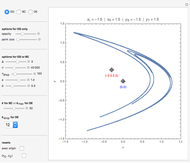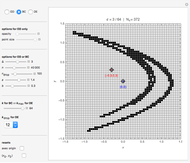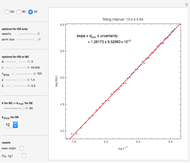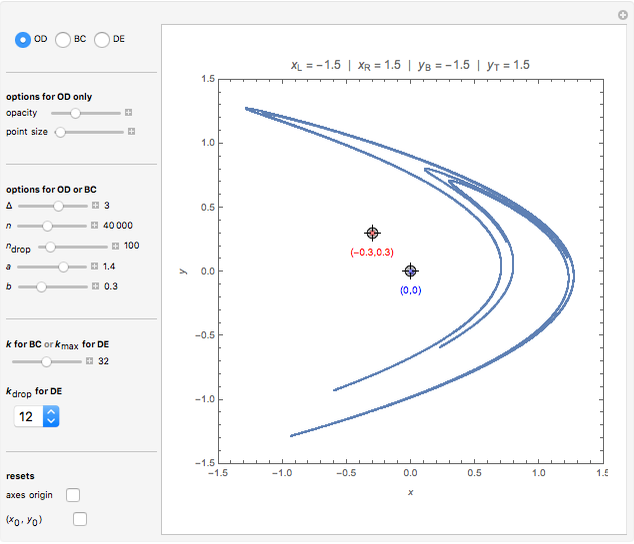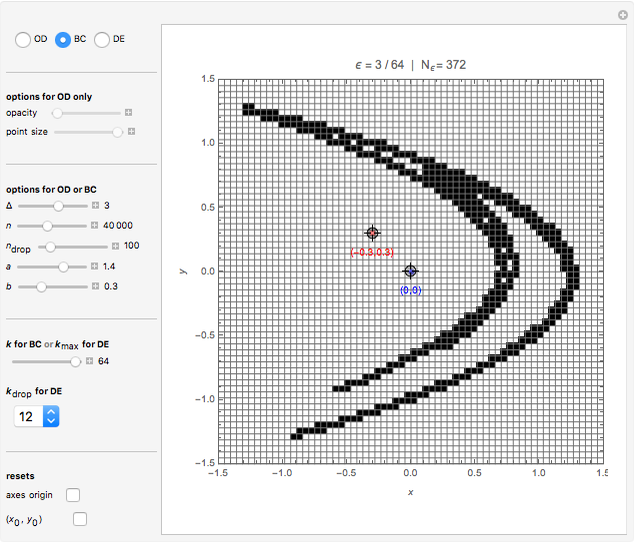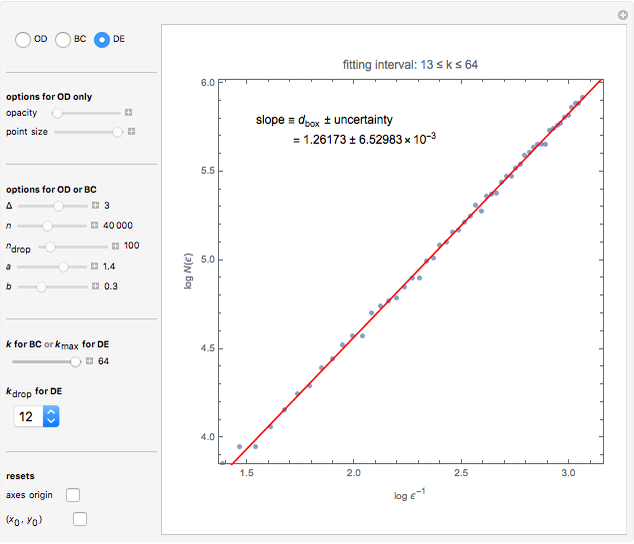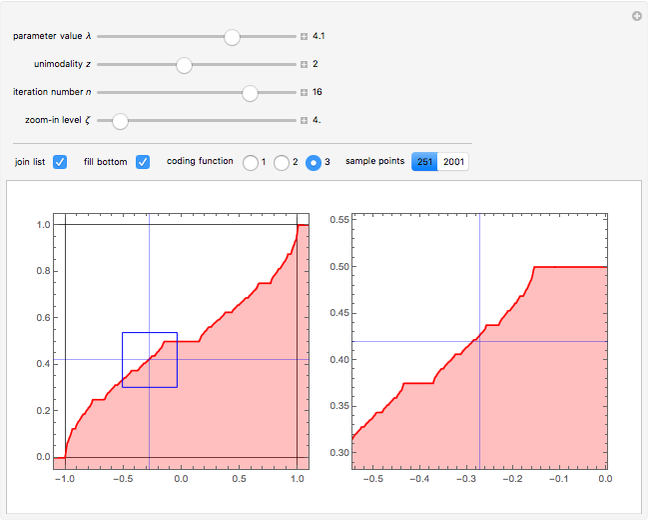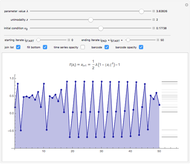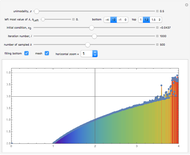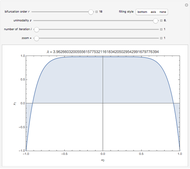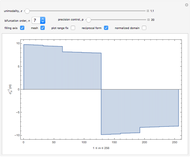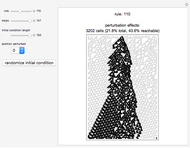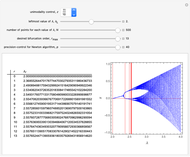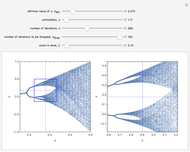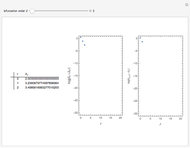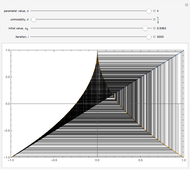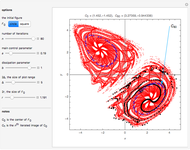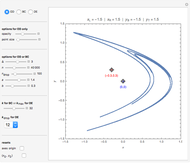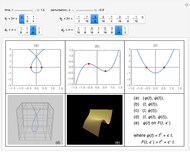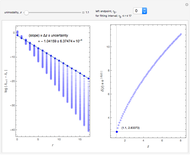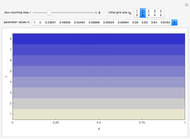Box-Counting Algorithm of the Hénon Map

Requires a Wolfram Notebook System
Interact on desktop, mobile and cloud with the free Wolfram Player or other Wolfram Language products.
This Demonstration shows the orbit diagram (OD), the box counting diagram (BC), and the dimension estimation plot (DE) of the Hénon map  [1–4]. It is known that the chaotic attractors in the Hénon map are neither area filling (dimension 2) nor a simple curve (of dimension 1) [4]. Therefore the dimensions of these complicated geometries must be non-integer values between 1 and 2, and the chaotic attractors are then called fractals or strange attractors [4, 5]. The capacity or box-counting dimension
[1–4]. It is known that the chaotic attractors in the Hénon map are neither area filling (dimension 2) nor a simple curve (of dimension 1) [4]. Therefore the dimensions of these complicated geometries must be non-integer values between 1 and 2, and the chaotic attractors are then called fractals or strange attractors [4, 5]. The capacity or box-counting dimension  is the simplest possible way to measure such pathologies. It can be defined by
is the simplest possible way to measure such pathologies. It can be defined by
Contributed by: Ki-Jung Moon (January 2014)
Open content licensed under CC BY-NC-SA
Snapshots
Details
The original Hénon map, which is given by  , is a prototypical example of a two-dimensional dissipative map with chaotic behavior. It was proposed by M. Hénon in 1976 as a simplified model of the Poincaré map (or Poincaré section) for the Lorenz model [1,8]. Hénon showed that the chaotic attractor of the Hénon map with
, is a prototypical example of a two-dimensional dissipative map with chaotic behavior. It was proposed by M. Hénon in 1976 as a simplified model of the Poincaré map (or Poincaré section) for the Lorenz model [1,8]. Hénon showed that the chaotic attractor of the Hénon map with  and
and  (also called the Hénon attractor) exhibits strange behavior (self-similarity), the typical behavior of fractal sets, via successive enlargement of the local region of the orbit diagram. Therefore the Hénon attractor is not only chaotic but also strange. These "Hénon-like" attractors are widely distributed within the parameter range
(also called the Hénon attractor) exhibits strange behavior (self-similarity), the typical behavior of fractal sets, via successive enlargement of the local region of the orbit diagram. Therefore the Hénon attractor is not only chaotic but also strange. These "Hénon-like" attractors are widely distributed within the parameter range  and
and  . They can also be found in other parameter regions. The maximally chaotic attractor for the Hénon map is known to occur at
. They can also be found in other parameter regions. The maximally chaotic attractor for the Hénon map is known to occur at  and
and  [9]. This Demonstration uses an alternative definition of the Hénon map
[9]. This Demonstration uses an alternative definition of the Hénon map  with the same dynamics [9].
with the same dynamics [9].
References
[1] M. Hénon, "A Two-Dimensional Mapping with a Strange Attractor," Communications in Mathematical Physics, 50(1), 1976 pp. 69–77.
[2] S. H. Strogatz, Nonlinear Dynamics and Chaos, New York: Perseus Books Publishing, 1994.
[3] K. T. Alligood, T. D. Sauer, and J. A. Yorke, Chaos: An Introduction to Dynamical Systems, New York: Springer, 1996.
[4] H.-O. Peitgen, H. Jurgens, and D. Saupe, Chaos and Fractals: New Frontiers of Science, 2nd ed., New York: Springer, 2004.
[5] B. Mandelbrot, The Fractal Geometry of Nature, San Francisco: W. H. Freeman, 1982.
[6] D. A. Russel, J. D. Hanson, and E. Ott, "Dimension of Strange Attractor," Physical Review Letters, 45(14), 1980 p. 1175.
[7] P. Grassberger and I. Procaccia, "Measuring the Strangeness of Strange Attractors," Physica, 9D(1–2), 1983 pp. 189–208.
[8] E. N. Lorenz, "Deterministic Nonperiodic Flow," Journal of the Atmospheric Sciences, 20(2), 1963 pp. 130-141.
[9] J. C. Sprott, "Maximally Complex Simple Attractors," Chaos: An Interdisciplinary Journal of Nonlinear Science, 17, 2007 p. 033124.
Permanent Citation




















